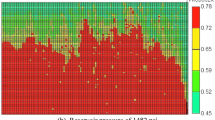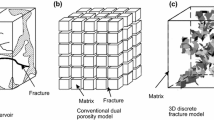Abstract
Numerical reservoir simulation is applied to obtain forecasts for flow in hydrocarbon reservoirs under different production strategies. Considering heterogeneities, which may occur in different length scales, there is significant interest in fractures. In naturally fractured reservoirs (NFRs), for example, differences in permeability and porosity values are due to geological factors. In this work, a numerical reservoir simulator was built for the purpose of studying gas flow in NFRs. The physical–mathematical modeling considers single-phase and isothermal three-dimensional flow. Non-Darcy effects are incorporated using Forchheimer’s equation and the Barree and Conway’s model for considering the inertial effects. The nonlinear partial differential equations are discretized by means of the finite-difference method along with a time-implicit approach. The numerical code also allows grid refinement to represent fractures and providing a better capture of physical phenomena close to fractures and wellbores. A preconditioned approximate factorization technique was chosen for the numerical solution due its ability to solve matrix equations for problems where heterogeneity is an important feature. Different production scenarios were studied for hydrocarbons recovery. It was possible to conclude that spatial distribution and wide variation of heterogeneity values have direct influence in the pressure and velocity fields in porous media, and also impact on the wellbore pressure profile. When non-Darcy flow occurs in naturally fractured reservoirs there is a counterbalance between fracture effects, which reduce wellbore pressure drop, and the inertial effects, that increase wellbore pressure drop. Therefore, an accurate modeling of these interactions is fundamental to forecast reservoir performance.




























Similar content being viewed by others
Abbreviations
- \(A_l\) :
-
Normal area on the l-direction (m\(^2\))
- B :
-
Formation-value-factor (m\(^3\)/std m\(^3\))
- \(c_{1},c_{2},c_{3},c_{4}\) :
-
Constants of the \(\varvec{\beta }\) correlation
- \(c_{\phi }\) :
-
Rock compressibility (Pa\(^{-1}\))
- D :
-
Depth (m)
- F, E :
-
Dimensionless constants
- g :
-
Gravity acceleration (m/s\(^2\))
- \(h_\mathrm{f}\) :
-
Fracture’s thickness (m)
- \(J_{w}\) :
-
Productivity index (std m\(^3\)/s Pa)
- \(k_{l}\) :
-
Permeability on the l-direction (m\(^2\))
- \(\mathbf {k}_\mathrm{app}\) :
-
Apparent permeability (m\(^2\))
- \(\mathbf {k}_\mathrm{min}\) :
-
Minimum permeability value at high flow rates (m\(^2\))
- \(L_l\) :
-
Length on the l-direction (m)
- M :
-
Molecular gas weight (kg/kg-mol)
- \(n_l\) :
-
Number of cells on the l-direction
- p :
-
Fluid pressure in porous media (Pa)
- \(p_\mathrm{sc}\) :
-
Pressure in standard conditions (Pa)
- \(p^0\) :
-
Pressure in a reference condition (Pa)
- \(P_i\) :
-
Initial pressure (Pa)
- \(q_{\rm m}\) :
-
Source term (kg/s)
- \(q_\mathrm{sc}\) :
-
Source term in standard conditions (std m\(^3\)/s)
- \(Q_\mathrm{sc}\) :
-
Production rate (std m\(^3\)/s)
- \(r_\mathrm{eq}\) :
-
Equivalent radius (m)
- \(r_{w}\) :
-
Wellbore radius (m)
- R :
-
Universal gas constant (J/mol K)
- t :
-
Time (days)
- \(t_\mathrm{max}\) :
-
Maximum time (s)
- tol:
-
Numerical tolerance (Pa)
- T :
-
Temperature (K)
- \(T_l\) :
-
Transmissibility on the l-direction (std m\(^3\)/s Pa)
- \(T_\mathrm{sc}\) :
-
Temperature in standard conditions (K)
- v :
-
Iterative level
- \(\mathbf {v}\) :
-
Superficial fluid velocity (m/s)
- \(V_\mathrm{b}\) :
-
Bulk volume (m\(^3\))
- x, y, z :
-
Coordinate directions (m)
- Z :
-
Real gas deviation factor
- \(\varvec{\beta }\) :
-
Inertial coefficient (m\(^{-1}\))
- \(\varvec{\delta }\) :
-
Deviation factor
- \(\Delta l_{i,j,k}\) :
-
Grid spacing on the l-direction (m)
- \(\Delta U_x\) :
-
Parameter of grid refinement
- \(\mu\) :
-
Viscosity (Pa s)
- \(\rho\) :
-
Density (kg/m\(^3\))
- \(\rho _\mathrm{sc}\) :
-
Density in standard conditions (kg/std m\(^3\))
- \(\phi\) :
-
Porosity
- \(\phi _0\) :
-
Porosity in a reference condition
- \(\tau _\mathrm{p}\) :
-
Porous media tortuosity
- \(\tau _\mathrm{c}\) :
-
Characteristic length (m\(^{-1}\))
References
Wu Y-S, Fakcharoenphol P, Zhang R (2010) Non-Darcy displacement in linear composite and radial flow porous media. Society of Petroleum Engineers Europec/EAGE Annual Conference and Exhibition, 14–17 June, Barcelona, Spain, 2010
Al-Otaibi A, Wu YS (2010) Transient behavior and analysis of non-Darcy flow in porous and fractured reservoirs according to the Barree and Conway’s Model. Society of Petroleum Engineers Western North America Regional Meeting, 26–30 May, Anaheim, California, USA, 2010
Wu Y-S, Lai B, Miskimins JL (2011) Simulation of non-Darcy porous media flow according to Barree and Conway Model. J Comput Multiph Flows 3(2):107–122
Tavares CAP, Kazemi H, Ozkan E (2006) Combined effect of non-Darcy flow and formation damage on gas-well performance of dual-porosity and dual-permeability reservoirs. Soc Petrol Eng Reserv Eval Eng 9:543–552
Biryukov D, Kuchuk FJ (2012) Transient pressure behavior of reservoirs with discrete conductive faults and fractures. Transp Porous Media 95:239–268
Mendes MA, Murad MA, Pereira F (2012) A new computational strategy for solving two-phase flow in strongly heterogeneous poroelastic media of evolving scales. Int J Numer Anal Methods Geomech 36:1683–1716
He J, Durlofsky LJ (2013) Reduced-order modeling for compositional simulation using trajectory piecewise linearization. Society of Petroleum Engineers Reservoir Simulation Symposium, 18–20 February, The Woodlands, Texas, USA, 2013
Nelson R (2001) Geologic analysis of naturally fractured reservoirs, 2nd edn. Gulf Professional Publishing, Houston
Tiab D, Donaldson EC (2004) Petrophysics, theory and practice of measuring reservoir rock and fluid transport properties, 2nd edn. Gulf Professional Publishing, Houston
Nair N, Bryant SL, Jennings JW (2008) Finding the continuum scale in highly heterogeneous rocks: example of a large touching vug carbonate. Society of Petroleum Engineers Annual Technical Conference and Exhibition, 21–24 September, Denver, Colorado, USA, 2008
Ertekin T, Abou-Kassem JH, King GR (2001) Basic applied reservoir simulation. Society of Petroleum Engineers, 2001
Jmili A, Wilhite GP, Green D (2011) Modeling gas-phase mass transfer between fracture and matrix in naturally fractured reservoirs. Soc Petrol Eng J 16:795–811
Barree RD, Conway MW (2004) A complete model for Darcy, Forchheimer, and trans-Forchheimer flow in porous media. Society of Petroleum Engineers Annual Technical Conference and Exhibition, 26–29 September, Houston, Texas, USA, 2004
Zeng F, Zhao G (2008) Semianalytical model for reservoirs with Forchheimer’s non-Darcy flow. Soc Petrol Eng Reserv Eval Eng 11:280–291
Li D, Robert K, Engler TW, Grigg RB (2001) Modeling and simulation of wafer non-Darcy flow experiments. Society of Petroleum Engineers Western Regional Meeting, 26–30 March, Bakersfield, California, USA, 2001
Lai B, Miskimins JL, Wu YS (2009) Non-Darcy porous media flow according to the Barree and Conway’s Model: laboratory and numerical modeling studies. Society of Petroleum Engineers Rocky Mountain Petroleum Technology Conference, 14–16 April, Denver, Colorado, USA, 2009
Dumkwu FA, Islam AW, Carlson ES (2012) Review of well models and assessment of their impacts on numerical reservoir simulation performance. J Petrol Sci Eng 82–83:174–186
Peaceman DW (1983) Interpretation of Well-block pressures in numerical reservoir simulation with nonsquare grid blocks and anisotropic permeability. Soc Petrol Eng J 23:531–543
Al-Mohannadi NS (2004) Simulation of horizontal well tests. PhD Thesis, Colorado School of Mines/Golden, 2004
Saad Y (2003) Iterative methods for sparse linear systems, 2nd edn. Burlington, Society of Industrial and Applied Mathematics
Dranchuk PM, Abou-Kassem JH (1975) Calculation of Z factors for natural gases using equations of state. J Can Petrol Technol 14:34–36
Lee AL, Gonzalez MH, Eakin BE (1966) The viscosity of natural gases. Petrol Technol Trans AIME 18:997–1000
De Souza G (2013) Acoplamento Poço-reservatório na Simulação Numérica de Reservatórios de Gás. PhD Thesis, Universidade Estadual do Norte Fluminense/Macaé, 2013
Computational Modeling Group (2009) IMEX, advanced oil/gas reservoir simulator, 2009
Jones SC (1987) Using the inertial coefficient, \(\beta\), to characterize heterogeneity in reservoir rock. Society of Petroleum Engineers Annual Technical Conference and Exhibition, 27–30 September, Dallas, Texas, USA, 1987
Acknowledgments
Authors gratefully thank Universidade do Estado do Rio de Janeiro, CAPES and CNPq for their support.
Author information
Authors and Affiliations
Corresponding author
Additional information
Technical Editor: Celso Kazuyuki Morooka.
This work was supported in part by the National Council for Scientific and Technological Development (CNPq-Brazil) through Grant 305958/2012-7 and Carlos Chagas Filho Foundation for Research Support of the State of Rio de Janeiro (FAPERJ-Brazil) through Grant E-26/210.378/2014.
Rights and permissions
About this article
Cite this article
de Souza, G., Souto, H.P.A. A comparative study of non-Darcy flows in naturally fractured gas reservoirs. J Braz. Soc. Mech. Sci. Eng. 38, 1701–1715 (2016). https://doi.org/10.1007/s40430-016-0486-x
Received:
Accepted:
Published:
Issue Date:
DOI: https://doi.org/10.1007/s40430-016-0486-x




